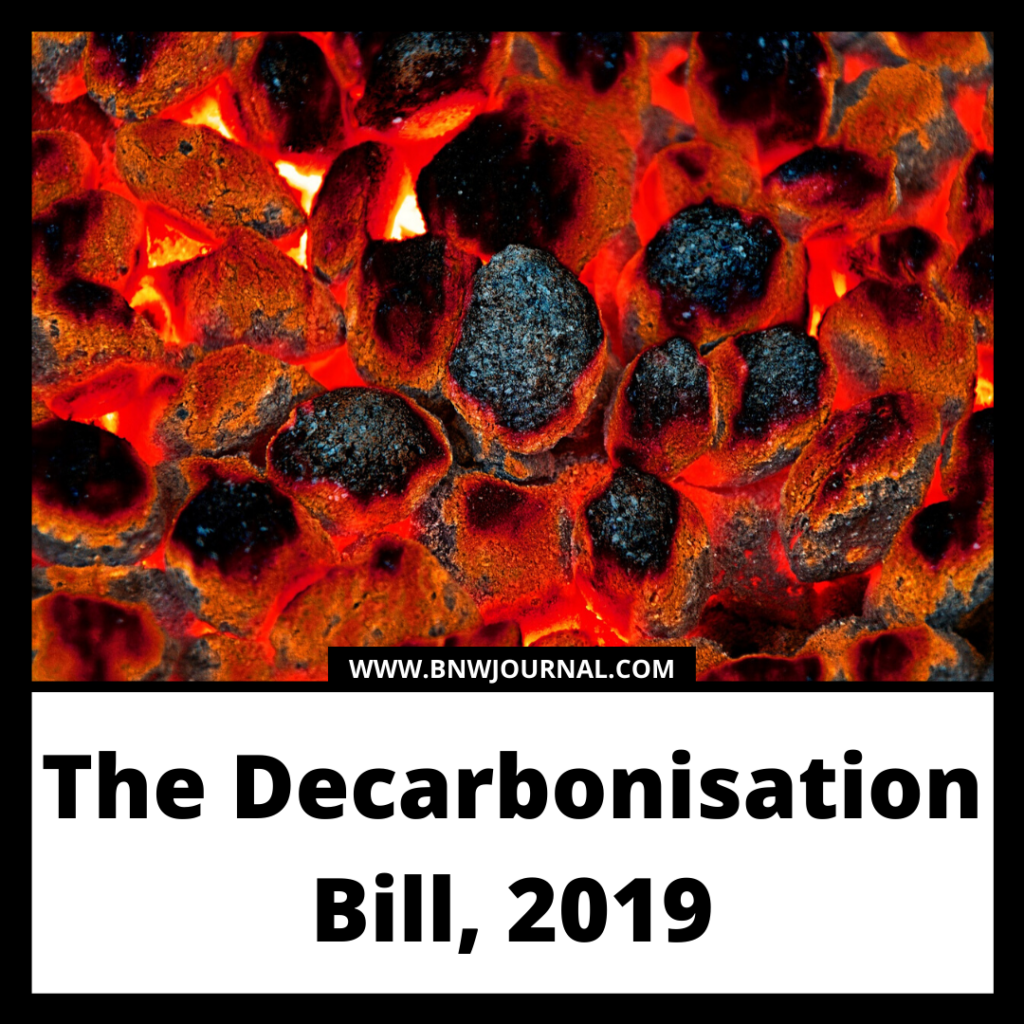![]()
Introduction
The Decarbonisation Bill, 2019 was a private bill introduced by Smt. Shanta Chhetri in the Rajya Sabha in December 2019. The primary aim of introducing this bill was decarbonizing the Indian economy. This bill sought to set higher environmental standards for air, water, and green spaces. It was also directed towards the protection and restoration of natural habitats. The bill stipulates setting up of a National Decarbon Board(NDB) and the State Decarbon Boards(SDB) under the Ministry of Environment, Forest and Climate Change.

Structure
The National Decarbon Board that has to be set up within 3 months of the commencement of the Act. It shall be head by the Prime Minister as its Chairperson. The members of the Board include Union Ministers of Earth Sciences, Agriculture & Farmer’s Welfare. Also Power, New & Renewable Energy, nominated representatives from the State government as well.
The proposed composition of the National Decarbon Board is very different, as compared to the Central Pollution Control Board (CPCB). The NDB has more number of Union Ministers. It also includes representation of NGOs, eminent conservationists, ecologists and environmentalists. This presence of these eminent personalities and NGOs working on the ground level will enhance the discussions and decision-making process. Likewise, every State shall set up a State Decarbon Board that has to be headed by the Chief Minister as its Chairperson, within 6 months of the commencement of this Act.
Functions
NDB is proposed as an advisory board to the Government of India that will keep a check on whether the decarbonization objectives are met along with the economic growth. This includes ensuring that there are zero net carbon emissions in India. Carbon neutrality is said to be achieved when a country balances carbon emissions with the carbon removals. To achieve the net-zero carbon footprint, the carbon removal processes like carbon offsetting have to be undertaken along with the overall reduction in emission levels. In addition to this, the Board has to also come up with suggestions to reduce the economic and social inequality in the country.
Accruing equal opportunities to all that will help us to reduce the wealth disparities should also be taken into consideration. The policy impact assessment and reviewing of progress shall also be the responsibility of this Board. Promotion policies consistent with the objectives of deacrbonisation shall be done on various international forums like G2o, World Bank, UN, etc. An annual report of the decarbonisation that has taken place shall be prepared and published by the Board. The salaries and allowances of persons working under the NDB shall be defrayed out of the Consolidated Fund of India.
Functions carried out by SDB
The functions of NDB are to be carried out by SDB at the state level. Additionally, the State Board also has to take appropriate steps for the improvement of energy efficiency in buildings. Usage of public transport and other modes like walking, cycling shall be promoted by the State Board. Measures shall be adopted to promote agroecological farming and other alternative reduced forms of consumption. Natural flood management systems and flood defence shall be strengthened.
Other crucial measures like reducing the use of water, an annual audit of biodiversity, clean energy development and so on shall be actively encouraged. A National Decarbon Fund as well as State Decarbon fund is proposed to be constituted through which the Boards shall receive grants and aids to carry out the functions.
Conclusion
The exploitation of natural resources and short term economic goals have led our country into a predicament. Although we are already analyzing all our policies from the perspective of achieving sustainable development goals, the setting up of decarbon advisory boards will ensure that all the policies are adequately scrutinized from this perspective. The responsibilities conferred upon the members are of great importance for the promotion of an alternative way of living.
Energy efficiency can also be increased significantly by replacing the fossil fuel reliant systems with the low-energy resources. This reduction in carbon emissions can also be done by the exponential growth of renewable energy sources. India is the third-largest emitter of Greenhouse gases in the world. There is a need to examine all policy decisions to reduce the level of air pollution. India is also susceptible to climate change to a large extent. This establishment of this Board will set a ten-year strategy that will prioritize community and employee-led transition. Institutionalization of these boards will ensure that concrete steps are taken by the government as well as citizens towards these aims. Constant efforts from all the actors will indeed lead to the protection and restoration of the natural balance in the ecosystem.



0 Comments